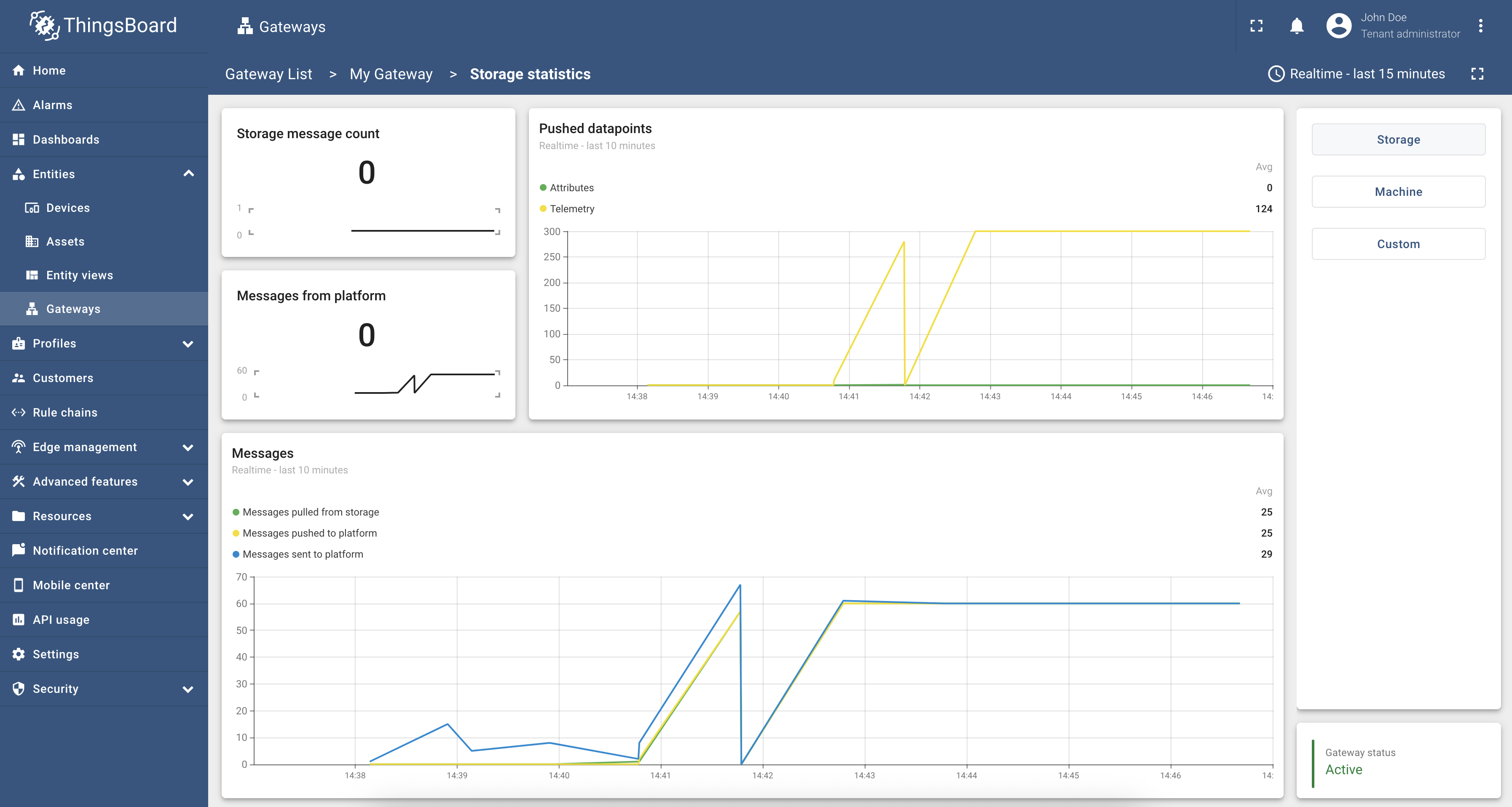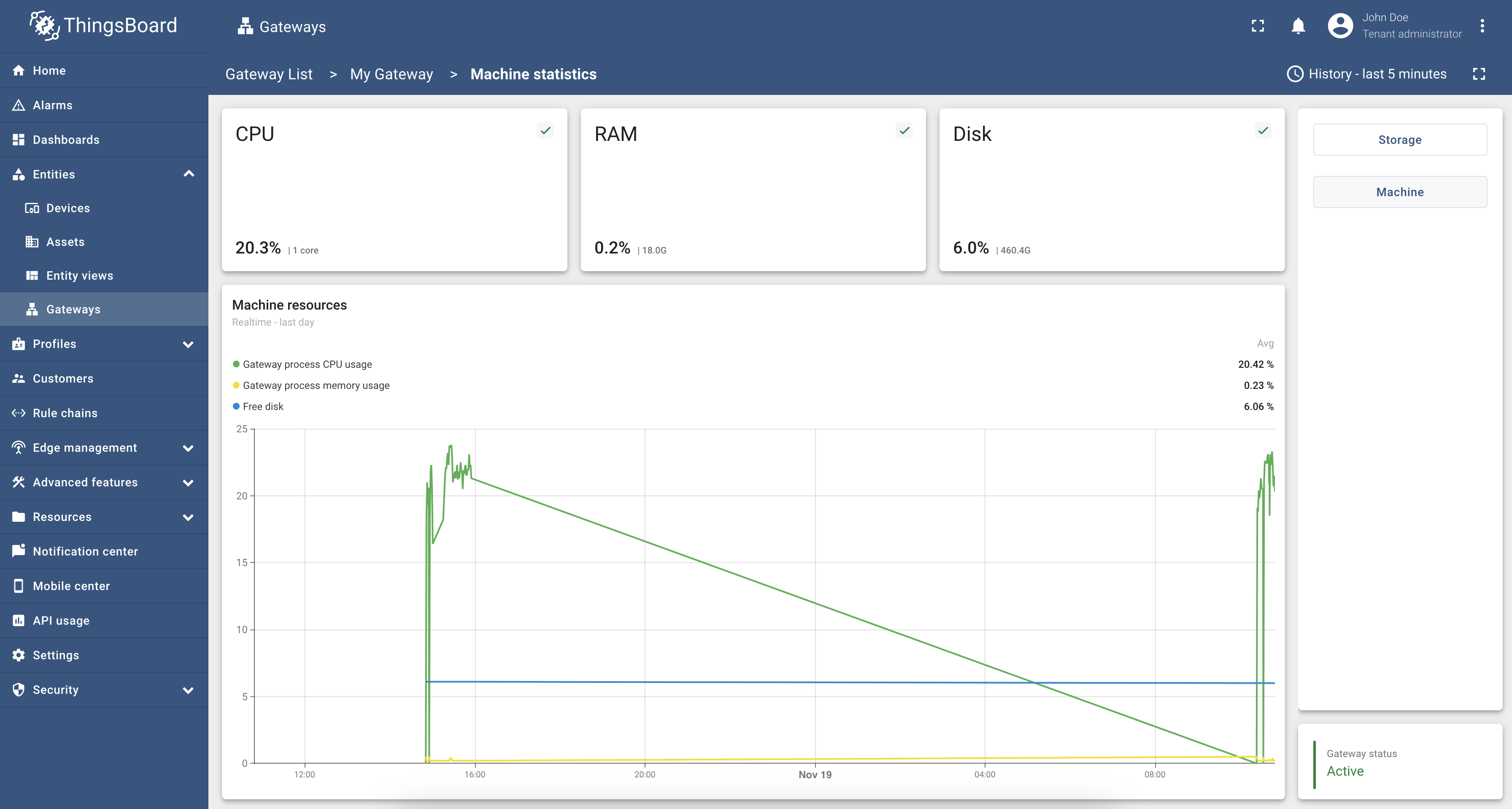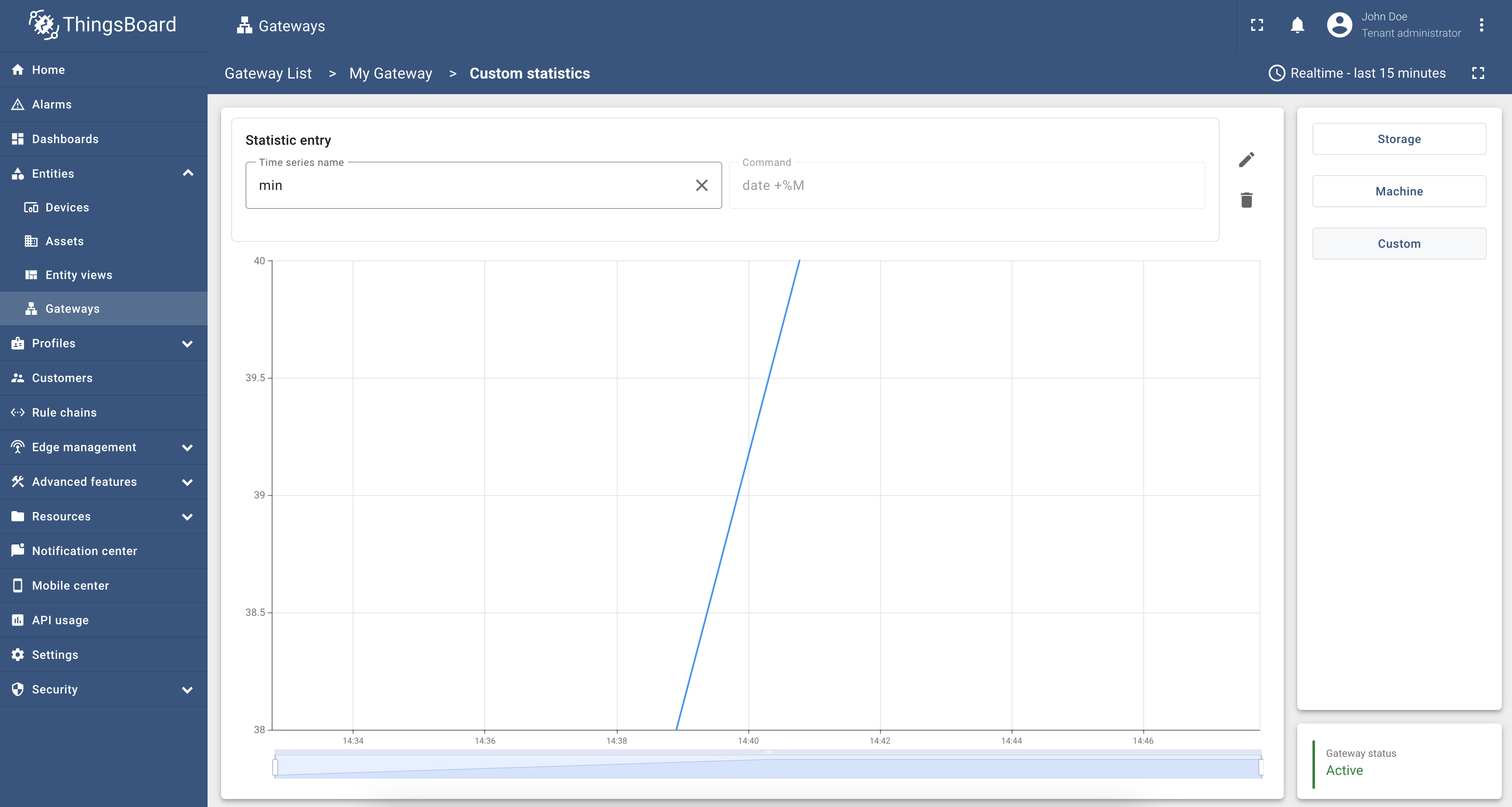Remote Configuration is a powerful feature of ThingsBoard IoT Gateway that allows you to manage and configure your gateway directly from the ThingsBoard web interface. This feature is especially useful for managing multiple gateways or when physical access to the gateway is limited.
For purpose of this guide, we will use following things:
- Locally installed instance of ThingsBoard platform (How to install you can read here).
- ThingsBoard IoT Gateway (How to install you can read here).
Gateway List
In order to remotely manage gateways, you need to go to the “Entities” > “Gateways” tab on the side menu of the ThingsBoard.
Gateway list page displays all your gateways and all the necessary details about them, namely:
- Date and time of creation.
- Name of the gateway.
- Status (Active/Inactive).
- Number of enabled connectors.
- Gateway version.
And also navigation elements:
- Launch command - when clicked, a modal window opens with a command to launch the gateway.
- Gateway configuration - when clicked, a modal window with general gateway settings opens.
- Connectors - when clicked, a page for managing and configuring connectors opens.
- Delete gateway - when clicked, a gateway deletion confirmation modal window opens.
On this page, you can create a new gateway, as well as sort them according to the parameters described above.

Gateway Info Page
If you select a gateway and click on it, you will be transferred to the page of the selected gateway.

The dashboard consists of 4 main widgets:
- General gateway information, which consists of the following cards:
- Status (Active/Inactive).
- Name of the gateway.
- Type of the gateway.
- Devices (Active/Inactive).
- Connectors (Enabled/Disabled) with link to Connectors page.
- Errors count with link to Logs page.

- Devices is a table that contains basic information about connected devices through the gateway:
- Device Name.
- Device Type.
- Status (Active/Inactive).
- Connector Name.
- Connector Type.
- Device info button that opens a modal window with detailed information about the device.
- As well as elements of filtering and searching for the necessary devices.

- Alarms is a standard alarm widget where you will receive all alarms related to selected gateway.

- Navigation Panel is a navigation panel on which all other pages for configuring, managing and monitoring the gateway are located, namely:
- Launch command - a modal window with an auto-generated command for launching the gateway.

- General configuration - page with general gateway settings.
- Connectors configuration - page with management and configuration of connectors.
- Logs - a page with various types of logs (it should be noted that the button is active only when Remote Logging is enabled on the gateway).
- Statistics - a page with general and custom statistics of the gateway.
- Remote Shell - page with Remote Shell (it should be noted that the button is active only when Remote Shell is enabled on the gateway).
- RPC - Gateway RPC sending page.
General Configuration
If you click on the General Configuration button on the gateway page in the Navigation Panel, you will be transferred to the dashboard general settings of the gateway.
You can switch configuration modes between Basic and Advanced. Basic mode provides a user-friendly interface for configuring the gateway, while Advanced mode allows you to edit the configuration file in JSON format directly.
Basic Configuration Mode
The page consists of the following tabs:
General - this tab contains the main settings, namely:
|
Logs - a tab for setting local and remote logs, which consists of 3 main sections:
|
Storage - provides configuration for saving incoming data before it is sent to the platform:
|
GRPC - provides GRPC configuration:
|
Statistics - in this tab you can configure general statistics, as well as custom statistics:
|
Other - in this tab, you can configure additional gateway parameters:
|
Advanced Configuration Mode
Advanced mode allows you to edit the configuration file in JSON format directly and useful for configuring complex settings that are not available in Basic mode.

Connectors Configuration
If you click on the Connectors configuration button on the gateway page in the Navigation Panel, you will be transferred to the Connectors configuration page.

The page consists of two main sections:
- Connectors list - basic information and control elements of all created connectors are displayed here:
- Enabled - enable or disable the connector.
- Name of connector.
- Type of connector.
- Configuration status - displays whether the remote configuration is synchronized with the local configuration.
- Status of the connector - if it is “green” - there are no errors, and the connector is working correctly. If it is “red” - the connector is not working correctly.
- Actions:
- RPC - dashboard for sending RPC through gateway to connector.
- Logs - dashboard with connector logs.
- Delete connector.
- Connector configuration - fields for configuring the connector.
Also, you can create a new connector by clicking on the + button in the top right corner of the page.
Logs
If you click on the Logs button on the gateway page in the Navigation Panel, you will be transferred to the Logs page.

The dashboard displays the main gateway log information in real time (General, Service, Connection, Storage, Extension):
- Created time.
- Level.
- Message.
Statistics
If you click on the Statistics button on the gateway page in the Navigation Panel, you will be transferred to the Statistics page.
In the right sidebar you can switch between Storage, Machine and Custom statistics. Also, you can check gateway status in the real time in the bottom right corner of the page.
Storage Statistics
Storage statistics display information about the storage used by the gateway. The page consists of the following widgets:
- Storage message count - displays the total number of messages stored in the gateway storage.
- Message from platform - displays the total number of messages received from the platform.
- Pushed datapoints char - displays the total number of telemetry and attributes data points pushed to the platform.
- Messages char - displays the total number of messages processed by the gateway:
- Messages pulled from storage - total number of messages pulled from storage.
- Messages pushed to platform - total number of messages pushed to the platform.
- Messages sent to platform - total number of messages sent to the platform.

Machine Statistics
Machine statistics display information about the gateway machine performance. The page consists of the following widgets:
- CPU usage - displays the current CPU usage percentage of the gateway machine.
- RAM usage - displays the current RAM usage percentage of the gateway machine.
- Disk usage - displays the current Disk usage percentage of the gateway machine.

Custom Statistics
Custom statistics display user-defined statistics of the gateway. You can add custom statistics in the Statistics tab on General configuration page or by clicking on Create new button in the “Time series name” field. Depends on the added custom statistics, the page will consist of different widgets: char widgets for numerical statistics and table widgets for string statistics.

Remote Shell
If you click on the Remote Shell button on the gateway page in the Navigation Panel, you will be transferred to the Remote Shell page.

The dashboard allows control of the operating system with the gateway from the Remote Shell widget.
RPC
If you click on the RPC button on the gateway page in the Navigation Panel, you will be transferred to the Gateway RPC sending page.

The page consists of 3 widgets:
- Service RPC - for sending RPC and viewing the result of command execution:
- Command - service gateway RPC (Ping, Stats, Devices, Update, Version, Restart, Reboot).
- Timeout - command execution time.
- Response - the result of executing the sent command.
- RPS Logs - displays gateway logs when processing the sent RPC.
- RPC debug terminal - widget for debugging gateway RPCs.
Next steps
Explore guides related to main ThingsBoard features:
- Data Visualization - how to visualize collected data.
- Device attributes - how to use device attributes.
- Telemetry data collection - how to collect telemetry data.
- Using RPC capabilities - how to send commands to/from devices.
- Rule Engine - how to use rule engine to analyze data from devices.











